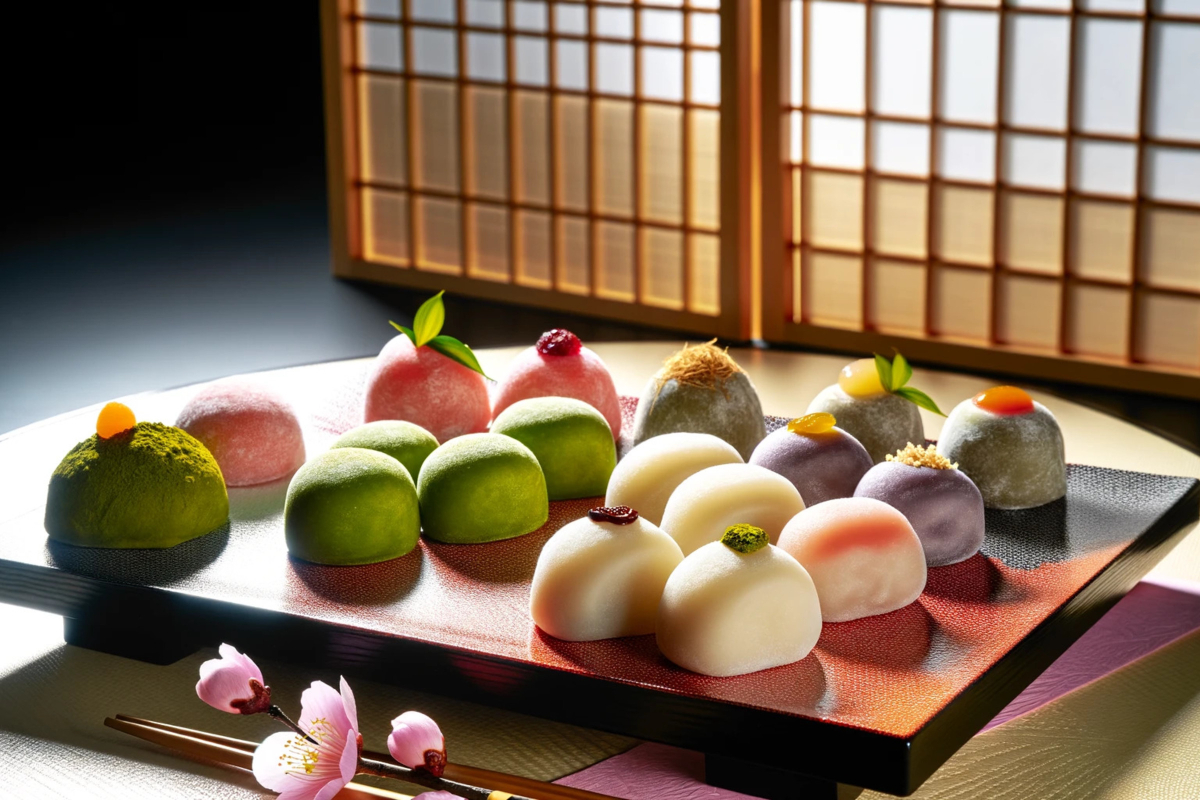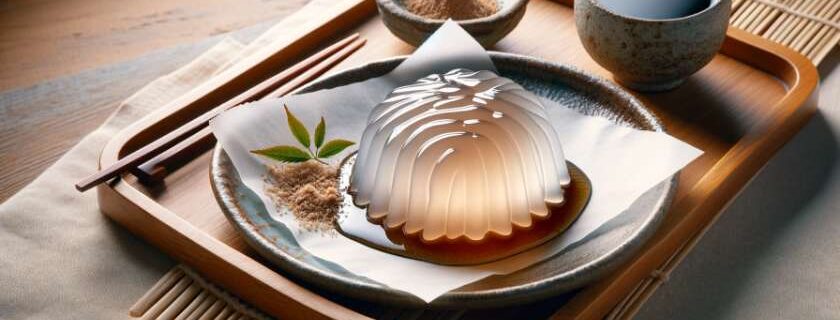
Indulge in a delectable journey through the world of Kyoto mochi. From traditional flavors to innovative twists, this listicle is your ticket to discovering the best this Japanese delicacy has to offer. Get ready to tantalize your taste buds with each chewy and flavorful bite as we explore a variety of Kyoto mochi creations that will leave you craving for more.
Join us as we delve into a selection of mouthwatering options, ranging from classic red bean paste fillings to modern interpretations like matcha and fruit-infused varieties. Scroll down to uncover our top picks and dive into a sweet symphony of textures and tastes that define the essence of Kyoto mochi.
- Key Takeaways
- 10 Best Kyoto Mochi Delights
- 1. Yatsuhashi – Cinnamon Flavored Mochi
- 2. Sakura Mochi – Cherry Blossom Infused Sweet
- 3. Daifuku – Sweet Red Bean Paste Filled Mochi
- 4. Kyo-gashi – Traditional Kyoto Confections
- 5. Warabi Mochi – Bracken Starch Jelly Mochi
- 6. Gion Mochi – Exclusive Geisha District Delicacy
- 7. Matcha Mochi – Green Tea Flavored Treats
- 8. Kuzu Mochi – Arrowroot Starch Mochi
- 9. Hanami Dango – Colorful Skewered Mochi Balls
- 10. Shingen Mochi – Water Cake Mochi
- Summary
- Frequently Asked Questions
Key Takeaways
- Try different types of mochi like Yatsuhashi, Sakura, and Matcha for a diverse tasting experience.
- Experience the rich cultural heritage of Kyoto through traditional confections like Daifuku and Kyo-gashi.
- Treat yourself to unique delicacies such as Gion Mochi, found only in the exclusive Geisha district.
- Discover the unique textures of mochi made from arrowroot starch (Kuzu Mochi) or bracken starch (Warabi Mochi).
- Enjoy seasonal delights like Hanami Dango during cherry blossom season or Shingen Mochi, a refreshing water cake mochi.
- Purchase or make mochi at home with different fillings and flavors to enjoy a personalized culinary adventure.
10 Best Kyoto Mochi Delights

1. Yatsuhashi – Cinnamon Flavored Mochi
Yatsuhashi, a traditional Kyoto mochi, boasts a delightful cinnamon taste that sets it apart from other varieties. Typically crafted into triangular shapes, this mochi is revered for its unique flavor profile and texture.
This popular sweet treat is not only enjoyed on its own but also serves as a versatile ingredient in an array of desserts and dishes. Its versatility makes it a favorite choice among chefs looking to infuse traditional Japanese flavors into their culinary creations.
In Kyoto, yatsuhashi holds cultural significance beyond its delectable taste; it symbolizes the rich heritage and craftsmanship of Japanese confectionery. This iconic mochi has become synonymous with the city’s culinary identity and is often sought after by tourists seeking an authentic taste of Kyoto.
Whether savored during tea ceremonies or incorporated into modern recipes, yatsuhashi continues to captivate food enthusiasts worldwide with its blend of sweet cinnamon goodness and symbolic representation of Kyoto’s culinary legacy.
2. Sakura Mochi – Cherry Blossom Infused Sweet
Sakura mochi is a delightful type of mochi that captures the essence of cherry blossoms, offering a unique and fragrant taste experience. This traditional Japanese sweet is wrapped in a pickled cherry leaf, infusing it with both flavor and aroma.
During the spring season, sakura mochi becomes a popular treat as people celebrate hanami, the tradition of enjoying the beauty of cherry blossoms. The delicate pink hue and floral notes make this mochi not only delicious but also visually appealing, adding to its charm.
In Japan, you can find sakura mochi in various sweet shops or even at special events dedicated to showcasing seasonal treats. Its popularity extends beyond just being enjoyed on its own; some innovative chefs have incorporated sakura mochi flavors into desserts like ice cream or pastries for an extra twist.
The cultural significance tied to sakura mochi makes it more than just a snack—it’s a symbol of nature’s beauty celebrated through culinary artistry during one of Japan’s most beloved seasons.
3. Daifuku – Sweet Red Bean Paste Filled Mochi
Daifuku, a traditional Japanese delicacy, features soft mochi enveloping a sweet red bean paste center. The blend of chewy mochi and velvety red bean paste offers a unique contrast in texture and taste.
Variety is the spice of life with Daifuku; it comes in an array of flavors beyond the classic red bean filling. From earthy matcha to fruity strawberry variations, there’s a Daifuku to suit every palate. Some innovative versions even boast ice cream fillings for an extra indulgent treat.
Whether you prefer the traditional azuki beans or more contemporary options like cream-filled varieties, Daifuku caters to diverse preferences. This versatility has made it a beloved confection not only in Japan but also globally as part of the growing trend towards Asian sweets.
4. Kyo-gashi – Traditional Kyoto Confections
Kyo-gashi, a category of traditional confections from Kyoto, encompasses various treats, including the beloved mochi. Crafted with precision and using top-tier ingredients, these sweets are renowned for their quality.
These confections stand out not only for their taste but also for their seasonal themes and intricate designs. This attention to detail makes them ideal choices for gifts or souvenirs that capture the essence of Kyoto’s culture and history.
In addition to being delightful treats, Kyo-gashi represents an art form deeply rooted in Japanese tradition [1]. The craftsmanship involved in creating these sweets has been perfected over years, making each piece a testament to time-honored techniques passed down through generations.
Whether you try them at specialized shops or savor them during a kaiseki meal at a traditional restaurant in Kyoto, experiencing Kyo-gashi is an essential part of immersing yourself in the city’s culinary heritage. These confections not only satisfy your taste buds but also offer a glimpse into the rich cultural tapestry of Japan’s former capital.

5. Warabi Mochi – Bracken Starch Jelly Mochi
Warabi mochi, a Kyoto delicacy, stands out for its unique texture derived from bracken starch. This type of mochi offers a jelly-like consistency that differs from the chewiness of traditional mochi.
Served chilled and dusted with kinako (roasted soybean flour), warabi mochi presents a refreshing twist on the classic dessert experience. The cool temperature enhances its delicate flavor, making it an ideal treat during the hot summer months in Kyoto.
This specialty showcases how Japanese cuisine can creatively adapt to seasonal preferences and local ingredients. The contrast between the soft, silky texture of warabi mochi and the nutty aroma of kinako creates a harmonious blend that delights both locals and tourists alike.
In essence, indulging in warabi mochi not only satisfies one’s sweet cravings but also provides a glimpse into the culinary ingenuity deeply rooted in Kyoto’s food culture.
6. Gion Mochi – Exclusive Geisha District Delicacy
Gion mochi is a specialty treat that traces its roots back to the historic Gion district in Kyoto. Crafted meticulously using time-honored techniques and top-notch ingredients, this delicacy embodies the essence of traditional Japanese confectionery.
This exclusive mochi is not just a snack; it’s an experience. Pairing Gion mochi with a steaming cup of matcha tea elevates the enjoyment to another level, offering a glimpse into the authentic flavors of Kyoto.
The allure of Gion mochi lies not only in its taste but also in its cultural significance. It serves as a gateway to understanding the rich heritage and culinary traditions deeply embedded in Kyoto’s fabric.
Indulging in Gion mochi isn’t just about satisfying your sweet tooth; it’s about immersing yourself in centuries-old customs and savoring every bite with reverence for the craftsmanship behind this delectable delight.
7. Matcha Mochi – Green Tea Flavored Treats
Matcha mochi is a delightful fusion of the rich essence of matcha, or powdered green tea, and the chewy goodness of mochi. These delectable treats offer a unique blend of flavors that cater to both sweet and savory palates.
These green tea flavored treats are commonly sprinkled with matcha powder, intensifying their taste profile with each bite. The dusting not only adds visual appeal but also enhances the overall experience by providing bursts of authentic matcha flavor.
Found in many Kyoto tea houses, matcha mochi has become a sought-after option for those who appreciate traditional Japanese flavors and textures. Its popularity among tea enthusiasts showcases its ability to satisfy cravings for both green tea and dessert in one indulgent package.
Whether enjoyed as a midday snack or as part of an elegant afternoon tea spread, matcha mochi stands out as a versatile treat that captures the essence of Kyoto’s culinary culture in every bite.
8. Kuzu Mochi – Arrowroot Starch Mochi
Kuzu mochi presents a delightful twist on traditional mochi by utilizing arrowroot starch as its base ingredient instead of glutinous rice. This alteration results in a unique appearance characterized by a translucent quality that sets it apart from the opaque regular mochi variety.
The texture of kuzu mochi is notably softer compared to conventional mochi, offering a more delicate and melt-in-your-mouth experience. This difference in texture adds an interesting dimension to the overall enjoyment of this Japanese treat.
Typically, kuzu mochi is served with either kuromitsu (brown sugar syrup) or kinako, enhancing its flavor profile with added sweetness. The combination of the subtle sweetness from these accompaniments and the soft texture of kuzu mochi creates a harmonious balance that delights taste buds.
In essence, if you are looking to explore new textures and flavors within the realm of traditional Japanese sweets, indulging in kuzu mochi can offer you a delightful culinary adventure.
9. Hanami Dango – Colorful Skewered Mochi Balls
Hanami dango are small mochi balls served on chopsticks, making them easy to enjoy during cherry blossom viewing parties in Japan. These colorful treats come in three distinct hues: pink, white, and green, symbolizing the progression of cherry blossoms from bud to full bloom.
The visual appeal of hanami dango is not just for show; it mirrors the changing stages of the iconic sakura flowers. Their chewy texture adds a delightful contrast to their vibrant appearance. Often priced around a few hundred yen per dish, these popular menu items can be found at many food stalls and shops near hanami spots during the spring season.
Pairing hanami dango with a cup of green tea enhances the overall experience by balancing out the sweetness with a touch of bitterness. It’s no wonder that these charming mochi balls attract long lines of locals and tourists alike eager to savor this traditional Japanese delicacy under blooming cherry trees.
10. Shingen Mochi – Water Cake Mochi
Shingen mochi, or water cake mochi, stands out for its jelly-like texture that sets it apart from traditional rice cakes. This unique dessert honors the preference of the renowned Japanese warlord Takeda Shingen.
Served with kinako (roasted soybean flour) and kuromitsu (brown sugar syrup), Shingen mochi offers a delightful fusion of flavors that appeals to a wide range of palates. The combination creates a balance between nutty and sweet tastes, enhancing the overall experience.
The name “water cake” originates from its appearance and consistency, resembling a clear droplet of water in solid form. This visual aspect adds an element of intrigue to this delicacy, making it not only delicious but also visually appealing.
Shingen mochi’s popularity has transcended borders, captivating food enthusiasts worldwide with its unique preparation method and exquisite taste profile. Its simplicity combined with complex flavors makes it a favorite among those seeking both novelty and tradition in their culinary experiences.

Summary
You’ve now delved deep into the world of Kyoto mochi, exploring a variety of flavors that make your taste buds dance with joy. From the classic sweetness of Daifuku to the elegance of Sakura Mochi, each bite tells a story of tradition and innovation. Just like a treasure trove waiting to be discovered, Kyoto’s mochi scene offers a glimpse into the rich cultural tapestry of Japan.
So, why not treat yourself to a culinary adventure and savor these delectable delights? Whether you’re a mochi aficionado or a curious foodie, exploring Kyoto’s diverse mochi creations is an experience you won’t want to miss. Let your taste buds travel to the ancient streets of Kyoto with every bite, immersing yourself in centuries-old flavors that continue to captivate hearts worldwide.
Frequently Asked Questions
What is the significance of Yatsuhashi in Kyoto mochi culture?
Yatsuhashi, with its cinnamon flavor, symbolizes the rich history and traditions of Kyoto. It’s a beloved treat that captures the essence of Japanese confectionery artistry.
Where can I find Gion Mochi in Kyoto?
Gion Mochi, an exclusive delicacy from the geisha district, can be savored at select traditional sweet shops nestled within the historic streets of Gion. Immerse yourself in both taste and tradition.
How does Sakura Mochi differ from other types of mochi?
Sakura Mochi stands out for its infusion of cherry blossom flavors, offering a delicate floral essence that evokes the beauty of springtime in every bite. It’s a unique and seasonal delight worth experiencing.
What makes Shingen Mochi stand out among other mochi varieties?
Shingen Mochi is renowned for its transparent appearance resembling a water cake. This innovative take on traditional mochi showcases culinary creativity while offering a light and refreshing texture like no other.
Are there any health benefits associated with consuming Warabi Mochi?
Warabi Mochi made from bracken starch jelly offers a gluten-free alternative packed with antioxidants and minerals. Indulge guilt-free in this chewy delicacy that not only delights your taste buds but also nourishes your body.




